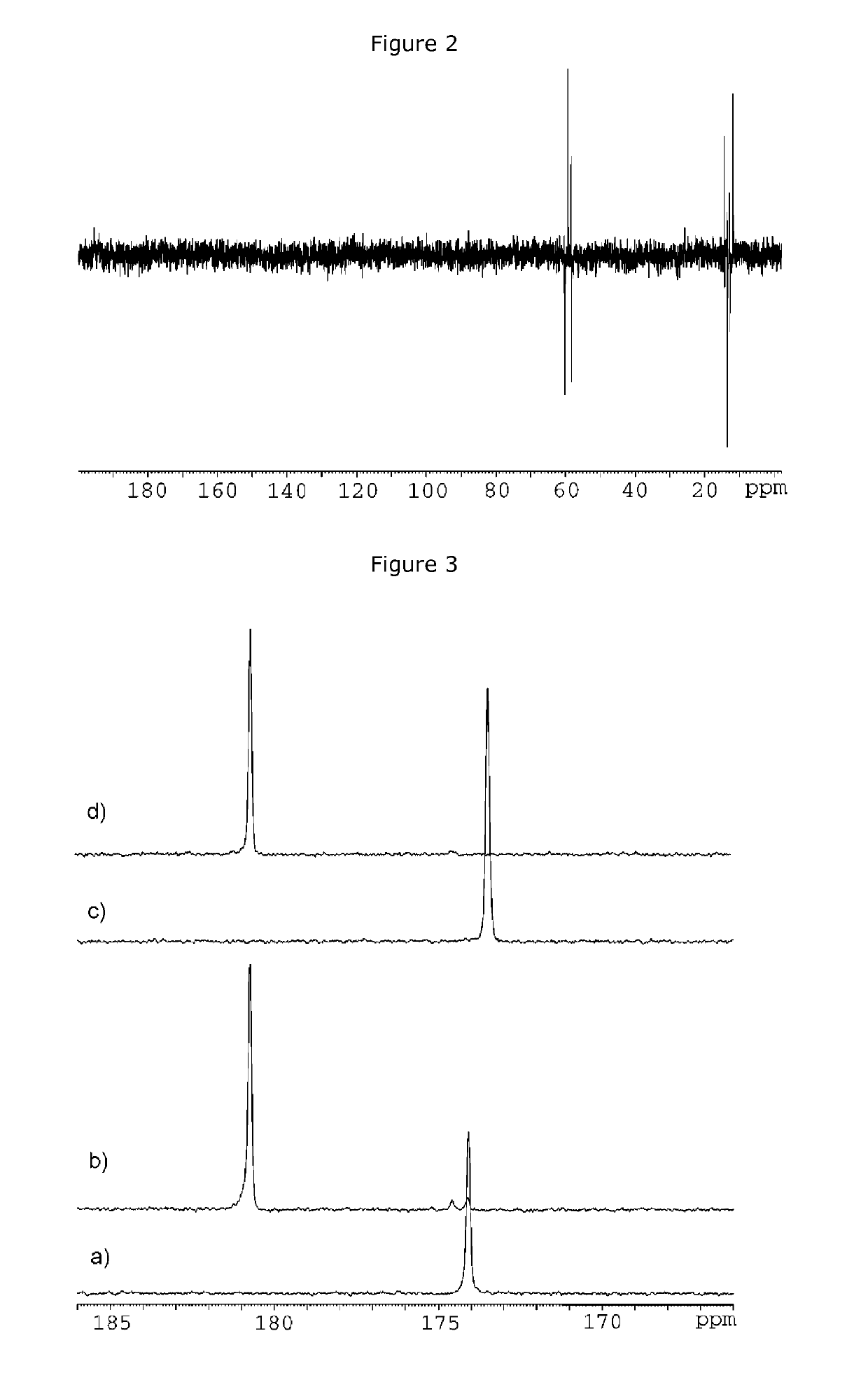Process for the preparation of hyperpolarized carboxylate compounds
a carboxylate compound and hyperpolarization technology, applied in the field of magnetic resonance imaging (mri), can solve the problems of polarization cycle, dnp-dissolution method requires sophisticated and expensive equipment, low sensitivity of nmr spectroscopy, etc., and achieves satisfactory polarization transfer, good yield and satisfying
- Summary
- Abstract
- Description
- Claims
- Application Information
AI Technical Summary
Benefits of technology
Problems solved by technology
Method used
Image
Examples
example 1
Preparation of [1-13C]-Hyperpolarized Acetate from Vinyl Ester: [1-13C]-Hyperpolarization Carried Out in an Aqueous Medium
[0180]
[0181]The Parahydrogenation of Vinyl-Acetate
[0182]The parahydrogenation of vinyl-acetate (purchased by Sigma-Aldrich; reference code V1505) has been carried out in water using the water soluble catalyst [Rh(NBD)phos][BF4] (NBD=norbornadiene, phos=1,4-bis[(phenyl-3-propane sulfonate)phosphine]butane disodium salt) (2.5 mM deuterated water solution) (this catalyst can be prepared e.g. according to the procedure reported in Magn. Reson. Mat. Phys. Biol. Med. 22, 123-34 (2009). The parandyrogenation reaction has been carried out into a NMR tube equipped with Young valve charged with 0.3 ml of catalyst, 0.03 mmol of substrate (3 μl, final concentration about 100 mM), 0.05 ml of methanol and 8 bar of parahydrogen (enriched at 77K, 50% enrichment).
[0183]Preparation of the [1-13C]-hyperpolarized Ethyl Ester
[0184]After warming the solution at 90° C., the NMR tube wa...
example 2
Preparation of [1-13C]-hyperpolarized Acetate from the Propargyl Ester: [1-13C]-hyperpolarization Carried Out in an Aqueous Medium
[0187]Synthesis of Propargyl Acetate
[0188]
[0189]Acetic acid (2.00 g, 34.1 mmol) and propargyl alcohol (2.29 g, 40.9 mmol) were heated for 4 h at reflux in C6H6 (120 cm3) in the presence of a catalytic amount of p-TsOH (0.32 g, 1.7 mmol) using a Dean-Stark apparatus. The reaction was allowed to cool to room temperature and was washed with saturated NaHCO3 (2×100 mL) and then with water (2×100 mL). The organic layer was collected and dried (with anhydrous Na2SO4), filtered and concentrated to yield the crude product as an odorless mobile yellow oil (1.67 g, 50%) which was used without further purification.
[0190]Preparation of the [1-13C]-hyperpolarized Acetate
[0191]The parahydrogenation reaction of the obtained propargyl ester has been carried out in an hydroalcoholic medium as formerly described in Example 1 for the acetate molecule and as schematized in s...
example 3
Preparation of [1-13C] Hyperpolarizd Pyruvate from Propargyl Ester: [1-13C]-hyperpolarization Carried Out in an Aqueous Medium and in Methanol / CDCl3
[0192]Synthesis of Propargyl Pyruvate
[0193]
[0194]Pyruvic acid (3.00 g, 34.1 mmol) and propargyl alcohol (2.29 g, 40.9 mmol) were heated for 4 h at reflux in C6H6 (120 cm3) in the presence of a catalytic amount of p-TsOH (0.32 g, 1.7 mmol) using a Dean-Stark apparatus. The reaction was allowed to cool to room temperature and was washed with sat. NaHCO3 (2×100 mL) and then with water (2×100 mL). The organic layer was collected and dried (anh. Na2SO4), filtered and concentrated to yield the crude product as an odorless mobile yellow oil (2.08 g, 49%) which was not purified further.
[0195]Preparation of the [1-13C]-hyperpolarized Pyruvate
[0196]Preparation of the [1-13C]-hyperpolarized Allyl-Ester in Aqueous Medium
[0197]The parahydrogenation of the propargyl-pyruvate has been carried out in an hydro-alcoholic hydrogenation medium (15% methano...
PUM
| Property | Measurement | Unit |
|---|---|---|
| T1 relaxation time | aaaaa | aaaaa |
| T1 relaxation time | aaaaa | aaaaa |
| T1 relaxation time | aaaaa | aaaaa |
Abstract
Description
Claims
Application Information
 Login to View More
Login to View More - R&D
- Intellectual Property
- Life Sciences
- Materials
- Tech Scout
- Unparalleled Data Quality
- Higher Quality Content
- 60% Fewer Hallucinations
Browse by: Latest US Patents, China's latest patents, Technical Efficacy Thesaurus, Application Domain, Technology Topic, Popular Technical Reports.
© 2025 PatSnap. All rights reserved.Legal|Privacy policy|Modern Slavery Act Transparency Statement|Sitemap|About US| Contact US: help@patsnap.com



